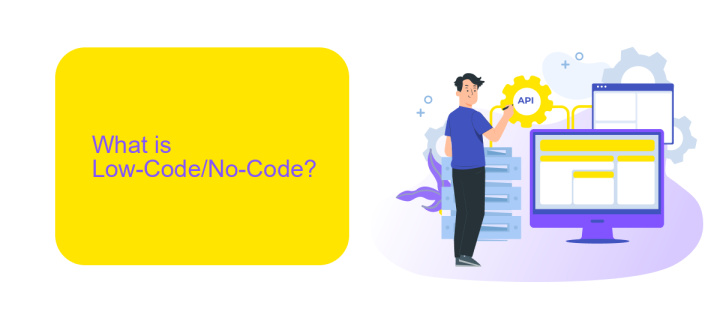Is Low-Code No-Code the Future
In an era where digital transformation is paramount, businesses are seeking more efficient ways to develop applications and automate processes. Low-code and no-code platforms have emerged as game-changers, democratizing software development by enabling users with little to no coding experience to create powerful applications. But is this trend merely a passing phase, or is it the future of technology?
Introduction
In recent years, the rise of low-code and no-code platforms has revolutionized the way businesses approach software development. These platforms empower users with minimal programming knowledge to create applications and automate workflows, significantly reducing development time and costs.
- Streamlined development processes
- Cost-effective solutions
- Empowerment of non-technical users
- Rapid prototyping and deployment
Among the tools facilitating this shift, ApiX-Drive stands out by enabling seamless integration of various services and applications without the need for extensive coding. As we delve deeper into the potential and challenges of low-code and no-code platforms, it becomes clear that they are poised to play a crucial role in the future of software development.
What is Low-Code/No-Code?

Low-Code and No-Code platforms are revolutionary tools designed to simplify the software development process. Low-Code platforms provide a visual development environment that allows users to drag and drop components, reducing the need for extensive hand-coding. This approach significantly accelerates the development cycle and enables both professional developers and non-technical users to create applications with minimal coding knowledge.
No-Code platforms take this concept a step further by eliminating the need for any coding at all. These platforms empower users to build fully functional applications through intuitive interfaces and pre-built templates. For instance, services like ApiX-Drive facilitate seamless integration between various applications without requiring any coding skills. Users can automate workflows and synchronize data across different platforms effortlessly, making it easier for businesses to streamline operations and enhance productivity.
Benefits and Limitations of Low-Code/No-Code

Low-code and no-code platforms are revolutionizing the way businesses approach software development, making it accessible to a broader audience. These platforms offer a range of benefits that can significantly streamline development processes and reduce costs.
- Speed: These platforms enable rapid application development, reducing the time to market.
- Cost-Effective: They lower development costs by minimizing the need for specialized coding skills.
- Accessibility: Non-developers can create applications, democratizing innovation within organizations.
- Integration: Tools like ApiX-Drive facilitate seamless integration with various services, enhancing functionality.
However, low-code and no-code platforms also come with limitations. They may not offer the same level of customization and control as traditional coding methods, potentially leading to scalability issues. Additionally, reliance on these platforms can result in vendor lock-in, restricting future flexibility. Despite these drawbacks, the advantages often outweigh the limitations, making low-code and no-code an attractive option for many businesses.
Future of Low-Code/No-Code

The future of Low-Code/No-Code (LCNC) platforms is incredibly promising as they continue to democratize software development. These platforms empower individuals with little to no coding experience to create applications, thus bridging the gap between business needs and technical capabilities. As businesses strive for agility and rapid digital transformation, LCNC solutions are becoming increasingly essential.
Advancements in artificial intelligence and machine learning are expected to further enhance LCNC platforms. These technologies can automate more complex tasks, making the development process even more accessible and efficient. Additionally, the integration capabilities of LCNC platforms are expanding, enabling seamless connectivity with various third-party services and APIs.
- Increased adoption in enterprise environments
- Enhanced AI and machine learning features
- Improved integration with services like ApiX-Drive
- Greater focus on security and compliance
Services like ApiX-Drive play a crucial role in the LCNC ecosystem by simplifying the integration process. They allow users to easily connect their applications with a wide range of external services, enhancing functionality without the need for complex coding. As LCNC platforms evolve, they will likely become the backbone of digital innovation, driving efficiency and creativity across industries.
Conclusion
As the demand for rapid and efficient software development continues to grow, Low-Code No-Code platforms are emerging as a pivotal solution. These platforms empower both technical and non-technical users to create applications swiftly, reducing the dependency on traditional coding skills. This democratization of app development is not only accelerating innovation but also bridging the gap between business needs and technological capabilities.
Moreover, the integration capabilities of Low-Code No-Code platforms, such as those offered by ApiX-Drive, further enhance their appeal. By simplifying the process of connecting various services and automating workflows, these platforms enable organizations to streamline operations and improve productivity. As technology continues to evolve, it is evident that Low-Code No-Code solutions will play a crucial role in shaping the future of software development, making it more accessible and efficient for all.
FAQ
What is Low-Code/No-Code development?
How does Low-Code/No-Code benefit businesses?
Are there any limitations to Low-Code/No-Code platforms?
Can Low-Code/No-Code platforms be integrated with existing systems?
Who can use Low-Code/No-Code platforms?
Apix-Drive is a universal tool that will quickly streamline any workflow, freeing you from routine and possible financial losses. Try ApiX-Drive in action and see how useful it is for you personally. In the meantime, when you are setting up connections between systems, think about where you are investing your free time, because now you will have much more of it.

